Ijraset Journal For Research in Applied Science and Engineering Technology
- Home / Ijraset
- On This Page
- Abstract
- Introduction
- Conclusion
- References
- Copyright
Sizing of Degradation Based Battery Storage Systems for Operating Cost Minimization in Microgrids
Authors: Dr. V S Sandeep Kumar Reddy, Mr Dhanmjaya Apparao Allam, Mr T Subrahmanyam
DOI Link: https://doi.org/10.22214/ijraset.2024.58448
Certificate: View Certificate
Abstract
A microgrid is a low voltage distribution network designed to provide power for small scale and isolated communities consisting of distributed generation and Energy Storage Systems .One of the major issues in the isolated microgrids with intermittent nature of distributed generation is the balance of energy demand. This can be achieved by appending renewable energy sources with suitable Battery Energy Storage Systems, to provide the reserve support in meeting the load demand. Battery degradation effect plays a major role in analysing the performance of BESS Life Time. This depends on average kWh and average MWh throughput discharge from BESS. Therefore, microgrid system with BESS considering degradation effect should be optimized in such a way as to obtain minimum operating cost while ensuring minimum electricity cost to customers. This paper presents an optimization algorithm for microgrid operating cost and customer electricity cost minimization for 24hrs time horizon while considering BESS degradation effect by determining kWh and MWh throughput. Particle Swarm Optimization (PSO), Accelerated particle swarm optimization (APSO), Jaya optimization (JAYA) technique and Linear programming interior point algorithm (LP-IP) have been applied to determine the optimal operating cost and electricity cost by simulating BESS degradation parameters.
Introduction
I. INTRODUCTION
Microgrid with Energy storage systems has become one of the promising solutions of future smart grid to overcome intermittent nature of Distributed Generations (DGs). Energy Storage Systems (ESS) has a wide range of performance requirements in terms of life time and discharge capacities. The microgrid configuration with ESS can address a variety of applications such as load levelling, renewable matching and meeting end user demand by distributing power to remote and isolated localities, to mitigate load fluctuations and improve power quality [1].BESS are one of the best choices to support the DGs in meeting reliability, as they are the sources of high power and energy densities. In the current scenario, Microgrid operations with Renewable energy sources and BESS are the preferred solutions in the grid and island connected mode to overcome energy crisis [2]. The intermittent nature of DGs can be overcome by using a suitable ESS particularly BESS, due to its high energy and power density. Therefore integration of distributed generations with storage reduces the disadvantage caused by generation of electricity from fuels [3]. This can be achieved by obtaining optimized maximum discharge rates of BESS and DGs within the limits of State of Charge (SoC) and power, the efficiency of the microgrid can be achieved without any limitations in power supply at the end user level [4-5].
Many techniques have been applied in literature to minimize the operating and electricity cost by optimizing the size of BESS in terms of its discharge capacities without considering the degradation effect-based life time .[6-8] Proposes a Mesh adaptive direct search algorithm (MADS) to determine the optimal operating strategy of microgrid with operating cost minimization .In [9] Fuzzy logic based controlled storage is proposed to determine optimal scheduling of microgrid for operating cost reduction.
[10] Presents a modified Differential evolution method to optimize total annual costs of the Microgrid using three sets of distributed energy sources considering load demand scenario. Adaptive modified firefly algorithm has been proposed in [11] to determine the operation management based uncertainty of DGs and Energy storage devices. [12] Proposed Particle Swarm Optimization (PSO) to find the size of BESS while achieving maximum benefit by obtaining minimum operating cost by means of peak levelling and energy saving techniques. Optimal size of BESS is determined in [13] while minimizing the total operating cost of microgrid considering unit commitment problem by using Genetic algorithm. In [14] novel scheduling based algorithm is proposed to optimize the total degradation cost and fuel consumption cost of microgrid in grid connected mode. Firefly Algorithm (FA) proposed in [15] minimizes the total operating cost by considering the capacity based life time degradation model obtaining the size of BESS. In [16] Mixed Integer Linear Programming (MILP) based optimization has been proposed to determine the lithium ion battery degradation assessments in microgird considering SOC range degradation models of BESS. [17] Model Predictive Control (MPC) approach is implemented to integrate the DGs into isolated smart microgrid system to improve the reliability of the system with BESS, neglecting the degradation effect. [18] Presented probabilistic operation and energy management of DERs in a microgrid system under uncertain environment using adaptive gravitational search algorithm considering BESS. Fuzzy based unit commitment model was developed in [19] to reduce carbon emission and to obtain optimal scheduling of DGs for considered Microgrid. From literature it is observed that the operating cost has been minimized without considering life time based degradation effect which results in obtaining infeasible solution and affects the system performance. This paper presents a hybrid renewable microgrid for which an optimal sizing of LI-BESS is carried out to optimize microgrid operating cost and electricity cost considering battery degradation effect.


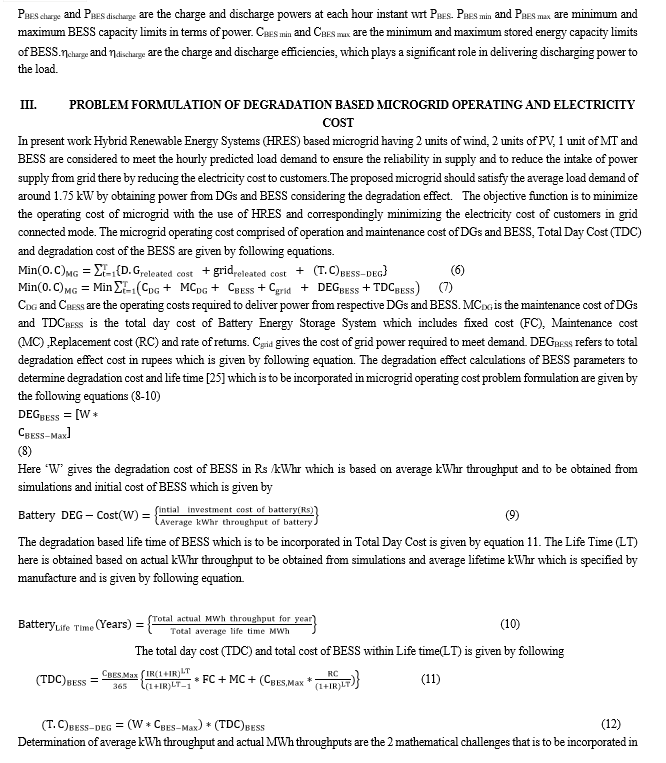

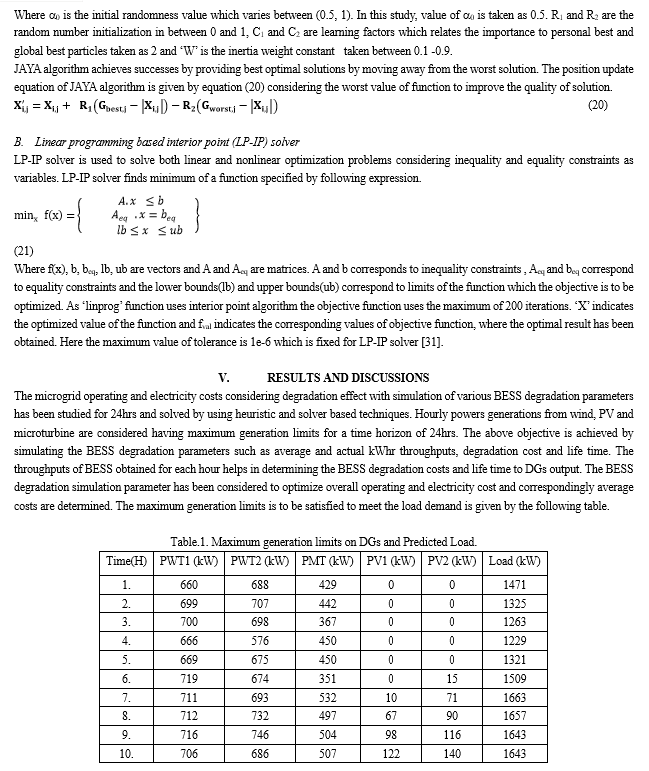
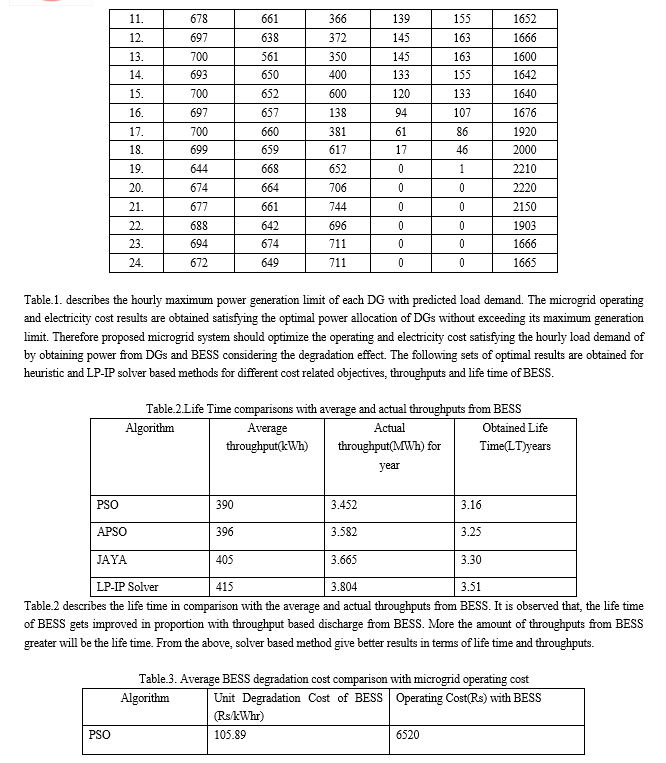
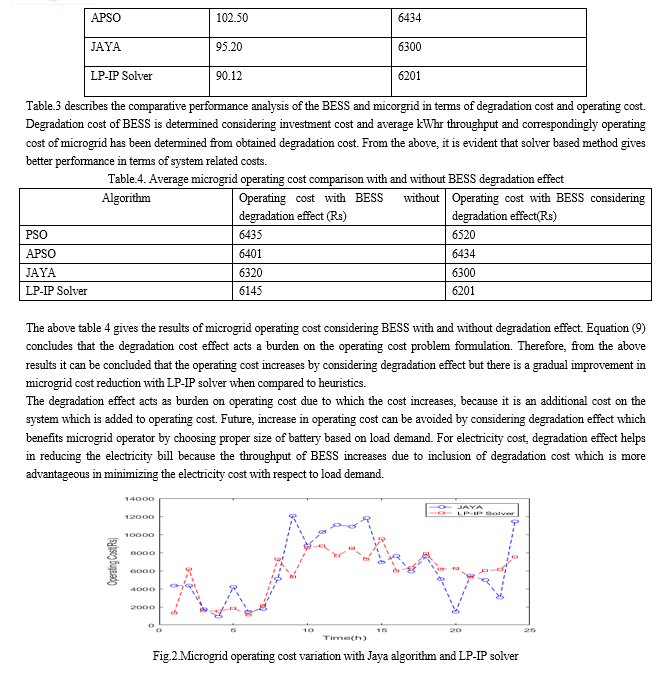
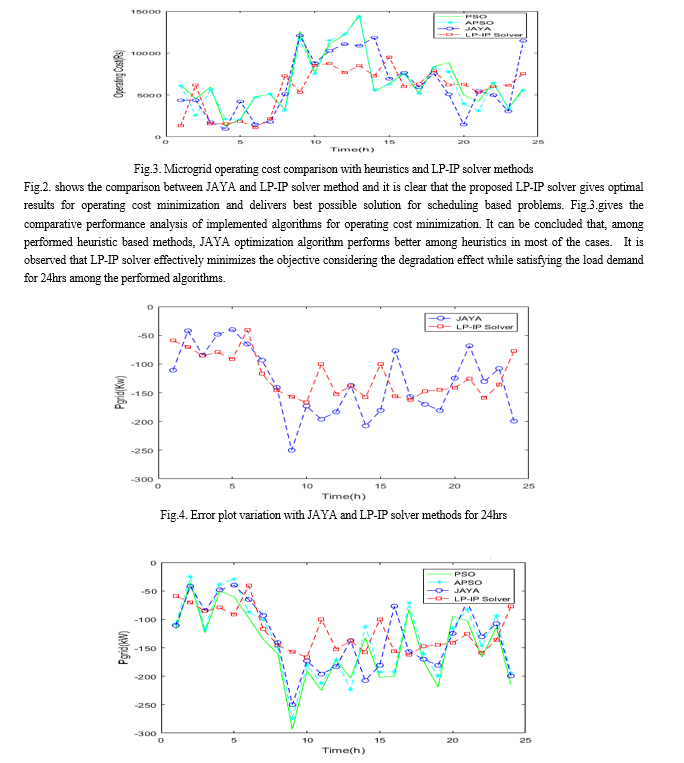

Conclusion
In this paper operating cost of microgrid has been minimized considering battery degradation effect based life time and correspondingly determined electricity cost to customers considering Hybrid Renewable Energy Resources (HRES).The objective is solved by determining the BESS degradation parameters and implementing with heuristic and LP-IP solver based techniques. The results show that, the LP-IP solver based approach gives optimal results for minimized microgrid operating cost considering BESS degradation effect and its simulation parameters, satisfying the load demand for 24hrs. For maximum throughput from BESS, the degradation cost and operating cost obtained is minimum. For battery capacity of 500kWh the optimal size of battery is determined to be in the range of (350-450kWh) for which the operating cost obtained is minimum. This work can be extended by considering the capacity based degradation depending on percentage degradation and SOC range to optimize the operating and electricity cost considering Hybrid Energy Storage Systems (HESS).
References
[1] Kumar, Abhishek & Hussain, D & Khan, Muhammad. (2018). Microgrids Technology: A Review Paper. Gyancity Journal of Electronics and Computer Science. 3. 11-20. 10.21058/gjecs.2018.31002. [2] Rangu, Seshu & Lolla, Phani & Raju, D & Singh, Arvind. (2020). Recent trends in power management strategies for optimal operation of distributed energy resources in microgrids: A comprehensive review. International Journal of Energy Research. 44. 10.1002/er.5649. [3] Bayu, Atinkut & Anteneh, Degarege & Khan, Baseem. (2021). Grid Integration of Hybrid Energy System for Distribution Network. Distributed Generation and Alternative Energy Journal. 10.13052/dgaej2156-3306.3738. [4] Zhao, Bo & Zhang, Xuesong& Chen, Jian & Wang, Caisheng& Guo, Li. (2013). Operation Optimization of Standalone Microgrids Considering Lifetime Characteristics of Battery Energy Storage System. Sustainable Energy, IEEE Transactions on. 4. 934-943. 10.1109/TSTE.2013.2248400. [5] Jiang, Quanyuan & Xue, Meidong & Geng, Guangchao. (2013). Energy Management of Microgrid in Grid-Connected and Stand-Alone Modes. Power Systems, IEEE Transactions on. 28. 3380-3389. 10.1109/TPWRS.2013.2244104. [6] Hesse, Holger & Martins, Rodrigo &Musilek, Petr & Naumann, Maik& Truong, Cong &Jossen, Andreas. (2017). Economic Optimization of Component Sizing for Residential Battery Storage Systems. Energies. 10. 835. 10.3390/en10070835. [7] Anvari-Moghaddam, Amjad &Seifi, Ali Reza &Niknam, Taher. (2012). Multi-operation management of a typical micro-grids using Particle Swarm Optimization: A comparative study. Renewable & Sustainable Energy Reviews - RENEW SUSTAIN ENERGY REV. 16. 10.1016/j.rser.2011.10.002. [8] Mohamed, Faisal &Koivo, Heikki. (2012). Multiobjective optimization using Mesh Adaptive Direct Search for power dispatch problem of microgrid. International Journal of Electrical Power & Energy Systems. 42. 728-735. 10.1016/j.ijepes.2011.09.006. [9] Fossati, Juan & Galarza, Ainhoa& Martín-Villate, Ander & Echeverria, Jose & Fontan, L.. (2015). Optimal scheduling of a microgrid with a fuzzy logic controlled storage system. International Journal of Electrical Power & Energy Systems. 68. 10.1016/j.ijepes.2014.12.032. [10] Som, T. & Chakraborty, N.. (2014). Evaluation of Different Hybrid Distributed Generators in a Microgrid—A Metaheuristic Approach. Distributed Generation & Alternative Energy Journal. 29. 49-77. 10.1080/21563306.2014.11442730. [11] Mohammadi, Sirus&Mozafari, Babak &Soleymani, Soodabeh. (2014). Optimal operation management of microgrids using the point estimate method and firefly algorithm while considering uncertainty. TURKISH JOURNAL OF ELECTRICAL ENGINEERING & COMPUTER SCIENCES. 22. 735-753. 10.3906/elk-1207-131. [12] Kerdphol, Thongchart&Qudaih, Yaser&Mitani, Yasunori. (2015). Optimal Battery Energy Storage Size Using Particle Swarm Optimization for Microgrid System. International Review of Electrical Engineering. 10. 277. 10.15866/iree.v10i2.5350. [13] Khorramdel, Hossein &Aghaei, J. &Khorramdel, Benyamin &Siano, Pierluigi. (2015). Optimal Battery Sizing in Microgrids Using Probabilistic Unit Commitment. IEEE Transactions on Industrial Informatics. 12. 10.1109/TII.2015.2509424. [14] rezaee jordehi, Ahmad. (2020). An improved particle swarm optimisation for unit commitment in microgrids with battery energy storage systems considering battery degradation and uncertainties. International Journal of Energy Research. 45. 10.1002/er.5867. [15] Sufyan, Muhammad & Abd Rahim, Nasrudin& Tan, Chia Kwang & Muhammad, Munir & Raihan, Siti. (2019). Optimal sizing and energy scheduling of isolated microgrid considering the battery lifetime degradation. PLOS ONE. 14. e0211642. 10.1371/journal.pone.0211642. [16] Jimenez, Diego & Ortiz Villalba, Diego & Perez, Aramis & Orchard, Marcos. (2018). Lithium-ion Battery Degradation Assessment in Microgrids. 10.1109/ROPEC.2018.8661410. [17] Parisio, Alessandra &Rikos, Evangelos&Glielmo, Luigi. (2014). A Model Predictive Control Approach to Microgrid Operation Optimization. Control Systems Technology, IEEE Transactions on. 22. 1813-1827. 10.1109/TCST.2013.2295737. [18] Bahmani-Firouzi, Bahman &Azizipanah-Abarghooee, Rasoul. (2014). Optimal sizing of battery energy storage for micro-grid operation management using a new improved bat algorithm. International Journal of Electrical Power & Energy Systems. 56. 42–54. 10.1016/j.ijepes.2013.10.019. [19] Zhou, H.-M. , Chen, Y. and Jiang, Q.- jie 2021. Optimal Combination Control Technology of Demand Side Resources of Distributed Renewable Energy Power Generation. Distributed Generation & Alternative Energy Journal. 36, 3 (Jul. 2021), 203–218. DOI:https://doi.org/10.13052/dgaej2156-3306.3631. [20] Bharti, Ruhi&Kuitche, Joseph &Tamizhmani, Govindasamy. (2009). Nominal Operating Cell Temperature (NOCT): Effects of module size, loading and solar spectrum. 001657 - 001662. 10.1109/PVSC.2009.5411408. [21] El-Ahmar, Mohamed & Ahmed, Abou-Hashema&Hemeida, Ashraf. (2017). Evaluation of factors affecting wind turbine output power. 1471-1476. 10.1109/MEPCON.2017.8301377. [22] Degobert, Philippe & Kreuawan, S & Guillaud, Xavier. (2006). Micro-grid powered by photovoltaic and micro turbine. [23] Shuaixun, Chen &Gooi, Hoay& Wang, Mingqiang. (2012). Sizing of Energy Storage for Microgrids. IEEE Trans. Smart Grid. 3. 142-151. 10.1109/TSG.2011.2160745. [24] P. Li, Z. Zhou and R. Shi, \"Probabilistic optimal operation management of microgrid using point estimate method and improved bat algorithm,\" 2014 IEEE PES General Meeting | Conference & Exposition, National Harbor, MD, USA, 2014, pp. 1-5, doi: 10.1109/PESGM.2014.6938932. [25] Chalise, Santosh & Sternhagen, Jason & Hansen, Timothy &Tonkoski, Reinaldo. (2016). Energy management of remote microgrids considering battery lifetime. The Electricity Journal. 29. 1-10. 10.1016/j.tej.2016.07.003. [26] A. Pérez, V. Quintero, H. Rozas, F. Jaramillo, R. Moreno and M. Orchard, \"Modelling the degradation process of lithium-ion batteries when operating at erratic state-of-charge swing ranges,\" 2017 4th International Conference on Control, Decision and Information Technologies (CoDIT), 2017, pp. 0860-0865, doi: 10.1109/CoDIT.2017.8102703. [27] Sharma, Sharmistha & Bhattacharjee, Subhadeep & Bhattacharya, Aniruddha. (2018). Probabilistic operation cost minimization of Micro-Grid. Energy. 148. 10.1016/j.energy.2018.01.164. [28] Wang, Dongshu& Tan, Dapei& Liu, Lei. (2018). Particle swarm optimization algorithm: an overview. Soft Computing. 22. 10.1007/s00500-016-2474-6. [29] Yang, Xin-She & Deb, Suash & Fong, Simon. (2012). Accelerated Particle Swarm Optimization and Support Vector Machine for Business Optimization and Applications. Communications in Computer and Information Science. 136. 10.1007/978-3-642-22185-9_6. [30] Venkata Rao, Ravipudi. (2016). Jaya: A simple and new optimization algorithm for solving constrained and unconstrained optimization problems. International Journal of Industrial Engineering Computations. 7. 19-34. 10.5267/j.ijiec.2015.8.004. [31] Cottle, Richard & Thapa, Mukund. (2017). INTERIOR-POINT METHODS. 10.1007/978-1-4939-7055-1_14.
Copyright
Copyright © 2024 Dr. V S Sandeep Kumar Reddy, Mr Dhanmjaya Apparao Allam, Mr T Subrahmanyam. This is an open access article distributed under the Creative Commons Attribution License, which permits unrestricted use, distribution, and reproduction in any medium, provided the original work is properly cited.

Download Paper
Paper Id : IJRASET58448
Publish Date : 2024-02-15
ISSN : 2321-9653
Publisher Name : IJRASET
DOI Link : Click Here
 Submit Paper Online
Submit Paper Online

